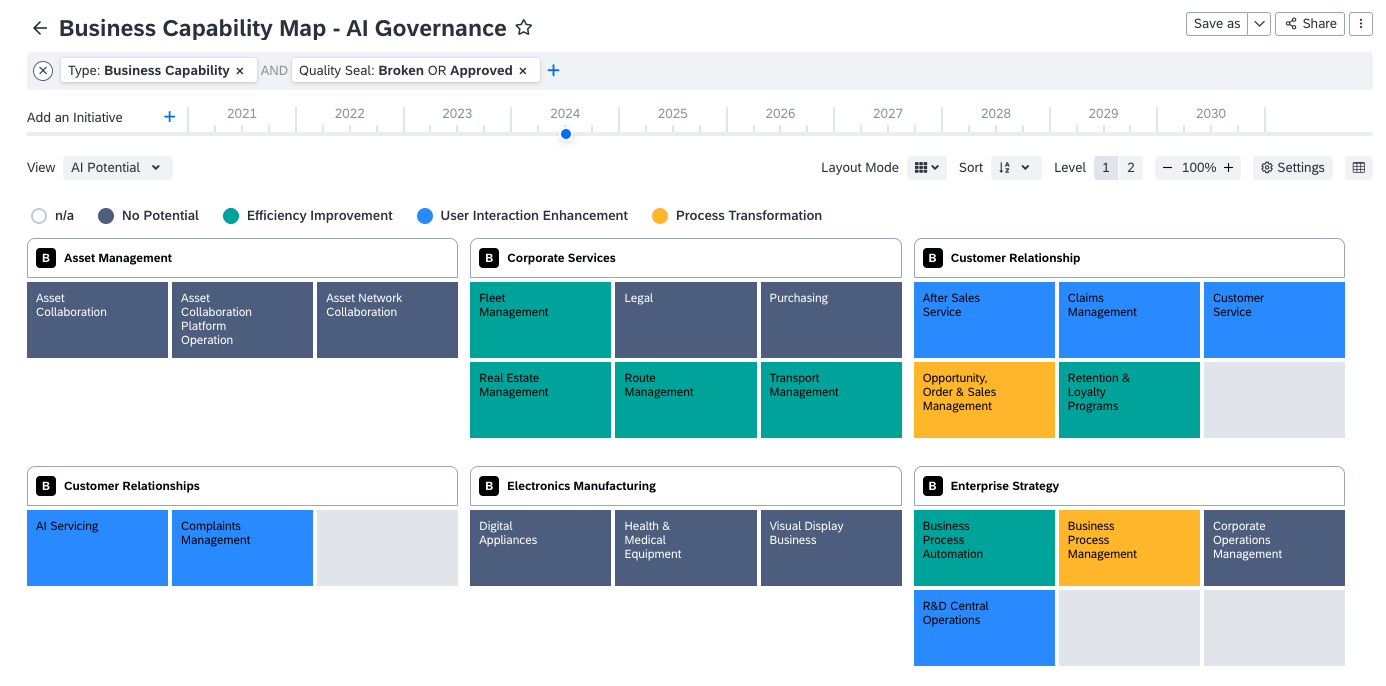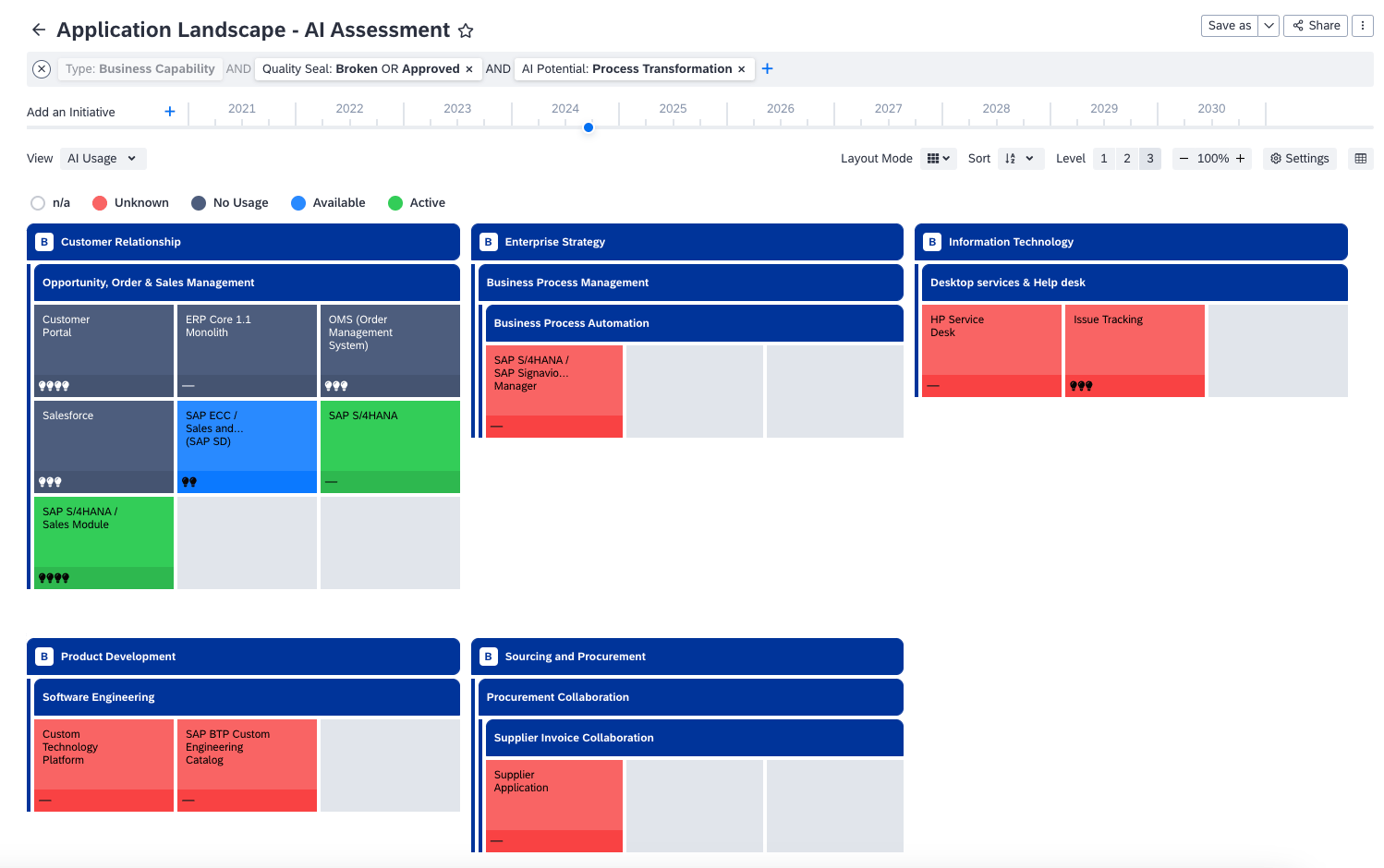Step 2: Assess AI Potential
Assess the potential of AI at both the business capability and application levels to identify where AI can deliver the most value.
After gathering initial AI-related information, the next step is to assess AI potential at both the business capability and application level. This assessment allows you to understand where AI can be most effectively deployed within your organization. It helps you identify areas where AI can deliver the most significant benefits, enabling you to prioritize your AI investments and strategies.
AI Potential on Business Capabilities
First, assess AI potential at the business capability level to identify where AI can be used most effectively within your organization, ensuring that AI investments are aligned with the overall business strategy.
For this assessment, use the Business Capability Map report available in SAP LeanIX by default. Apply the AI Potential view to the report and, if needed, use additional filters to further refine the report data. To learn more about using this report type, see Landscape Report.

Business Capability Map Report with the AI Potential View Applied
AI potential on business capabilities is represented by the following values. You can complete the assessment step by step, from the highest to the lowest potential:
- Process Transformation: First, identify business capabilities where AI has the potential to disrupt or transform existing processes. These are areas where AI technologies can enable new ways of working, create new business models, or significantly enhance the value delivered to customers.
- User Interaction Improvement: Next, look for business capabilities where AI can enhance user interaction. This could include areas where AI technologies like chatbots, recommendation systems, or personalized marketing can improve the user experience, engagement, and accessibility, as well as facilitate multilingual communication.
- Efficiency Improvement: Next, identify business capabilities where AI is associated with efficiency improvement. These are areas where AI technologies can automate routine tasks, streamline workflows, and improve operational efficiency.
- No Potential: Finally, identify business capabilities with no AI potential, including those where AI usage should be deliberately avoided. These are areas that won't benefit from AI technologies, and therefore, investments in AI are not needed.
By carefully assessing business capabilities in this way, you can identify those with the highest AI potential. This strategic approach ensures that AI technologies are leveraged where they can deliver the maximum value.
AI Potential on Applications
After assessing AI potential at the business capability level, evaluate AI potential at the application level to gain a more detailed understanding of where to leverage AI technologies within your organization. This assessment can inform decisions about where to invest in AI technologies, which applications to prioritize for AI integration, and how to align AI adoption with business strategy.
For this assessment, use the Application Landscape report and adjust it as follows:
- Navigate to report settings by clicking Settings in the upper-right corner, then do the following:
- In the Cluster By list, select Business Capabilities.
- Under Multiple Properties, set AI Potential as an additional property (for example, left property).
- Apply the AI Usage view to the report by selecting it in the upper-left corner.
Once you’ve adjusted the report view, you can use additional filters to further refine the report data. As a best practice, you can first focus on applications related to business capabilities with the highest AI potential to determine which specific applications can best support these capabilities. In the left-side pane, apply a filter to only show business capabilities with the highest AI potential (marked as Process Transformation).

Application Landscape Report Clustered by Business Capabilities Used for Assessing AI Potential on Applications
To get started, assess the AI potential on applications using the corresponding additional property.
- Applications with medium or high AI potential can significantly benefit from AI technologies, either by improving their performance, enhancing their functionality, or enabling new capabilities.
- Applications with low or very low AI potential are unlikely to benefit significantly from AI technologies. For these applications, it may be more cost-effective to focus on other improvement initiatives rather than AI integration.
After this initial assessment, analyze how AI is currently employed in applications in relation to its potential. This will help you identify which applications have the most to gain from AI technologies. You can proceed as follows:
- Identify applications with high potential and active usage: These applications are effectively leveraging AI and delivering significant value. They should be prioritized for further investment and development.
- Identify applications with high potential and unknown or no usage: These applications represent opportunities for improvement. Investigate why AI is not being used in these applications and consider strategies to increase AI adoption.
- Identify applications with low potential and active usage: These applications may indicate that resources are being wasted on AI technologies that aren't delivering proportional value. Consider redirecting these resources to applications with higher AI potential.
- Identify applications with unknown AI usage: Applications with unknown AI usage, regardless of their AI potential, represent a potential risk. These could be shadow AI applications that need to be brought under governance.
By analyzing the Application Landscape report in this way, you can gain insights into the relationship between AI potential and AI usage in your organization. This can inform your AI governance and adoption strategies, helping you to focus your efforts where they will deliver the most value.
Recommendation
A good practice is to first target about 10% of areas where immediate changes are needed, then focus on another 30% for the next phase of changes, leaving the rest for later. This gradual approach reduces the risk of business disruption, which could occur if you try to implement AI everywhere at once.
Once you've assessed the potential of AI on business capabilities and applications, you can evaluate AI-related risks. See Step 3: Evaluate AI-Related Risks.
Updated 9 months ago
